Stress changes due to the March 11, 2011, Tohoku Off-shore megathrust earthquake (Mw9.0) and related seismicity patterns.
The
great Tohoku earthquake occured on March 11, 2011, 14:46 Japan Time, at
the subduction of the Pacific Plate unde the North American Plate.
Besidees the "traditional" aftershock activity, this major event
triggered significant earthquake activity in the inland areas of Japan
as well, at relatively large distances. We are mostly concerned here in
estimating the static stress changes in various inland and
off-shore regions in and around the Japanese islands and estimate the
potential of future triggered seismicity. Moreover, the stress change
patterns are compared with the seismicity patterns after the major
earthquake to establish possible correlations. However, the JMA catalog
is still under continuos improvement for the time period immediately
following the major earthquake, therefore we focus at this moment on
analysing mainly the stress changes. Updates will be made continuosly. Moreover, we have
detected some interesting seismicity patterns before the
mega-earthquake, which we also present below.
A) Seismicity patterns with a possible precursory character
Starting
about one month before the major Tohoku earthquake (Mw8.9) a seismic
swarm, which shows a clear space-time migration pattern (see page 2 of
our pdf file), occurred in the region. The swarm appears to stop
shortly and is then followed by the Mw7.2 large event on March 9. After
only two days the Mw8.9 earthquake struck.
The pdf file can be downloaded from:
http://www.rcep.dpri.kyoto-u.ac.jp/~benescu/seismicity_pattern_2011_Tohoku.pdf
Please
check Marsan and Enescu (JGR, 2012), for a thorough discussion
of the pre-Tohoku earthquake (M9.0) seismicity pattern:
http://www.rcep.dpri.kyoto-u.ac.jp/~benescu/Work/Marsan_Enescu_JGR_2012.pdf
B) Coulomb static stress changes and seismicity
The Coulomb static stress changes due to
the recent Mw9.0 earthquake are calculated on various receiver planes, using the slip distribution of Suzuki et al.
(2011), obtained from the inversion of regional waveform data. For more information about this slip model we refer to the web page below (in Japanese):
http://www.bosai.go.jp/news/oshirase/20110315_01.pdf
The calculations have been done using the Coulomb 3.1 software
(Toda et al., 2005). We have used an apperent coefficient of friction of 0.4, if not otherwise specified.
Fault slip model (NIED, Suzuki et al., 2011) used for the stress change calculations:
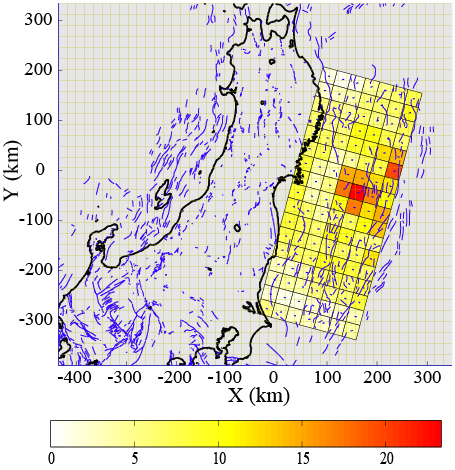
Ammount of net slip on the fault (m); Suzuki et al., 2011
1. Effect on the Tokai plane
One
of the regions in Japan that is of great concern for seimic hazard, is
the so-called Tokai region, located at the subduction of the Philippine
Sea Plate under the Eurasian Plate. Our analysis shows that there is no
significant influence on the Tokai fault plane due to the great Tohoku
earthquake.
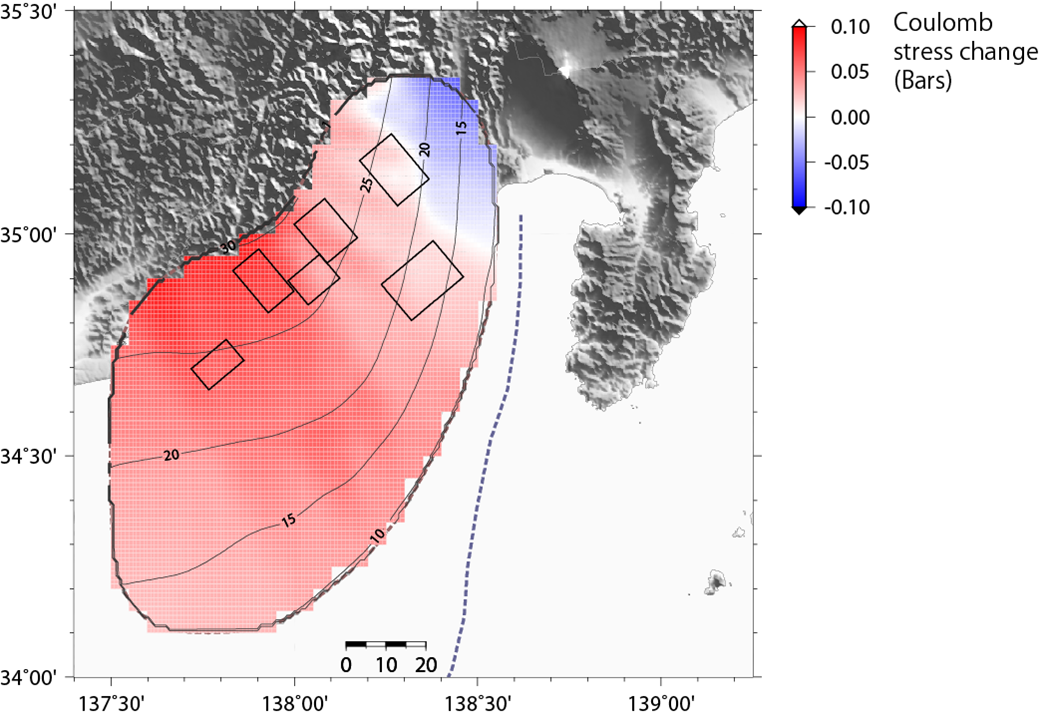
Coulomb
stress changes (Bars) on the presumed Tokai fault plane, due to the
2011 Tohoku Off-shore earthquake (slip distribution by Suzuki et al.,
2011). For detailes related to the location and geometry
of the
Tokai plane, see Aoi et al. (Nature Geoscince, 2011). The six
rectangles show presumed asperities on the Tokai plane (Matsumura et
al., 1998; 2008).
The
stress has an increase on most of the
Tokai plane, however the maximum increase is less than ~0.1 Bars (0.01
Mpa). It was observed that in general stresses larger than 0.1 Bars can
trigger earthquakes, with delays ranging from seconds to decades (e.g.,
Parson et al., Nature, 2008; Aoi et al., Nature Geoscience, 2010).
Thus, only the increase of stress due to the 2011 Tohoku earthquake is
unlikely to trigger significant earthquake activity on the Tokai plane.
However, the increase of seismicity in several crustal areas
around the Tokai gap, likely due to a stress increase by the
Tohoku earthquake, can have indirect consequences on the stress state
at the plate boundary. The Shizuoka earthquake (Mw5.9), occurred on
March 15, 2011 (i.e., after about 4 days from the Tohoku earthquake) is
such an example of earthquake likely triggered by the stress increase
due to the Tohoku earthquake (see point 2 below).
2. Effect on the fault plane of the Shizuoka earthquake (Mw5.9), occurred on March 15, 2011
On
March 15, 2011, a moderate earthquake occurred in the Shizoka region,
at bout 20 km from the northern, shallow edge of the Tokai plane .
The stress shows a significant relative increase, which suggests
the possiblity of static stress triggering.
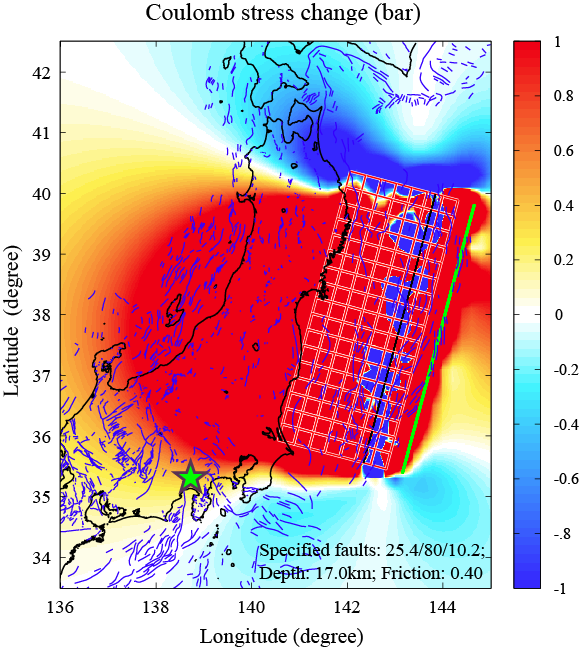
Coulomb
stress change (bars), resolved on receiver faults of Strike =
25.4 deg, Dip = 80 deg and Rake = 10.2 deg, at 17 km depth. These
parameters have been chosen based on the CMT focal mechanism solution
for the Shizuoka mainshock and the hypocentral distribution of its
aftershocks.
(NIED; http://www.hinet.bosai.go.jp/topics/e-shizuoka110315/). The star shows
the epicenter of the Shizuoka earthquake (Mw5.9). The increase of
stress at the hypocenter is of about 0.4 bars. Stresses of more than
0.1 bar have been shown to bring faults to failure.
3. Stress changes on various receiver planes
Stress
changes in various regions of Japan, using as receiver faults those
determined by Toda & Enescu (EPS, 2011), for the CSEP forecasting
project. The receiver faults are based on focal mechanism solutions
determined by F-net, NIED, as well as geologic information (e.g., type
of faults). The paper of Toda & Enescu (EPS, 2011) can be
downloaded from the EPS journal web site (for those with subscription)
or from the following link:
http://www.rcep.dpri.kyoto-u.ac.jp/~benescu/Work/Toda_Enescu_EPS_2011.pdf
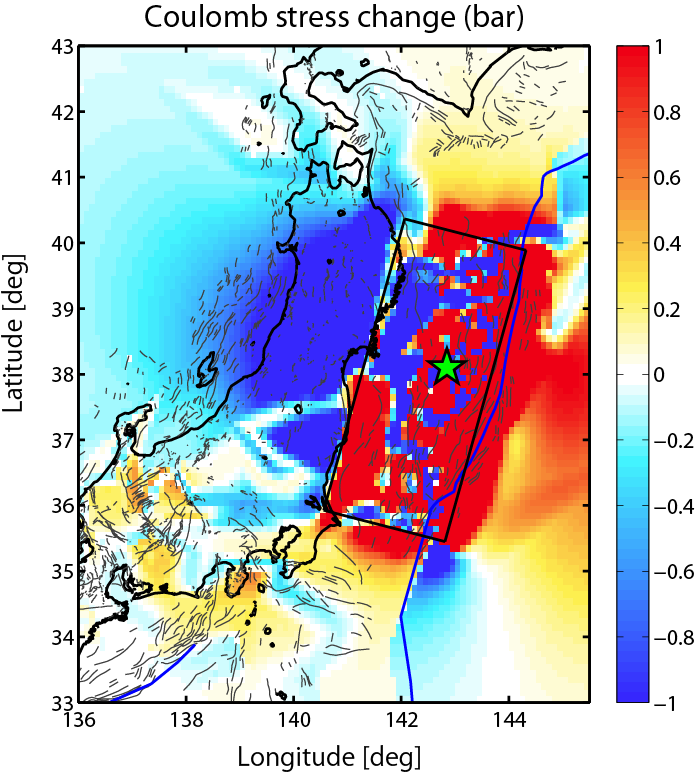
The
results show areas of possible activation or decreased earthquake
activity. Most of the reverse faults in the Tohoku region show a stress
shadow (blue). Relatively large positive stress changes can be seen at
the north and south extremities of the mainshock fault, as well as in
the outer rise characterized by normal faulting. Some regions in
southwest Japan have been also brought closer to failure (positive
stress changes of up to about 0.6 Bar).
3. Stress changes resolved on the nodal planes of aftershocks
We
used the CMT focal mechanism solutions determined by Asano et al.
(2011), who used the approach of Ito et al. (2007). The figures reveal
a clear correlation betwwen the positive stress changes and the
occurence of the aftershocks, in particular for the case of focal
mechanism solutions that are not consistent with the focal mechanism of
the mainshock.
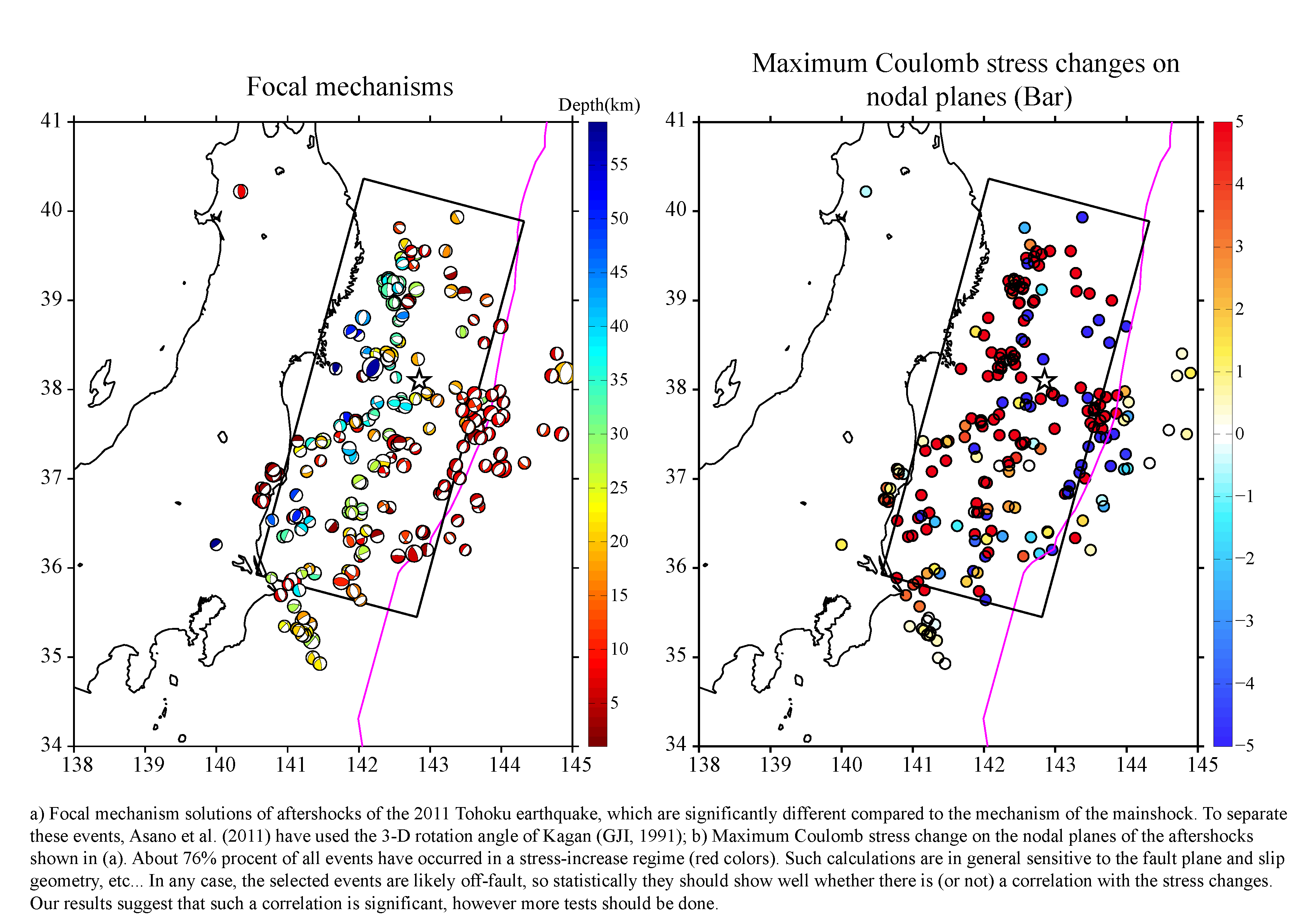
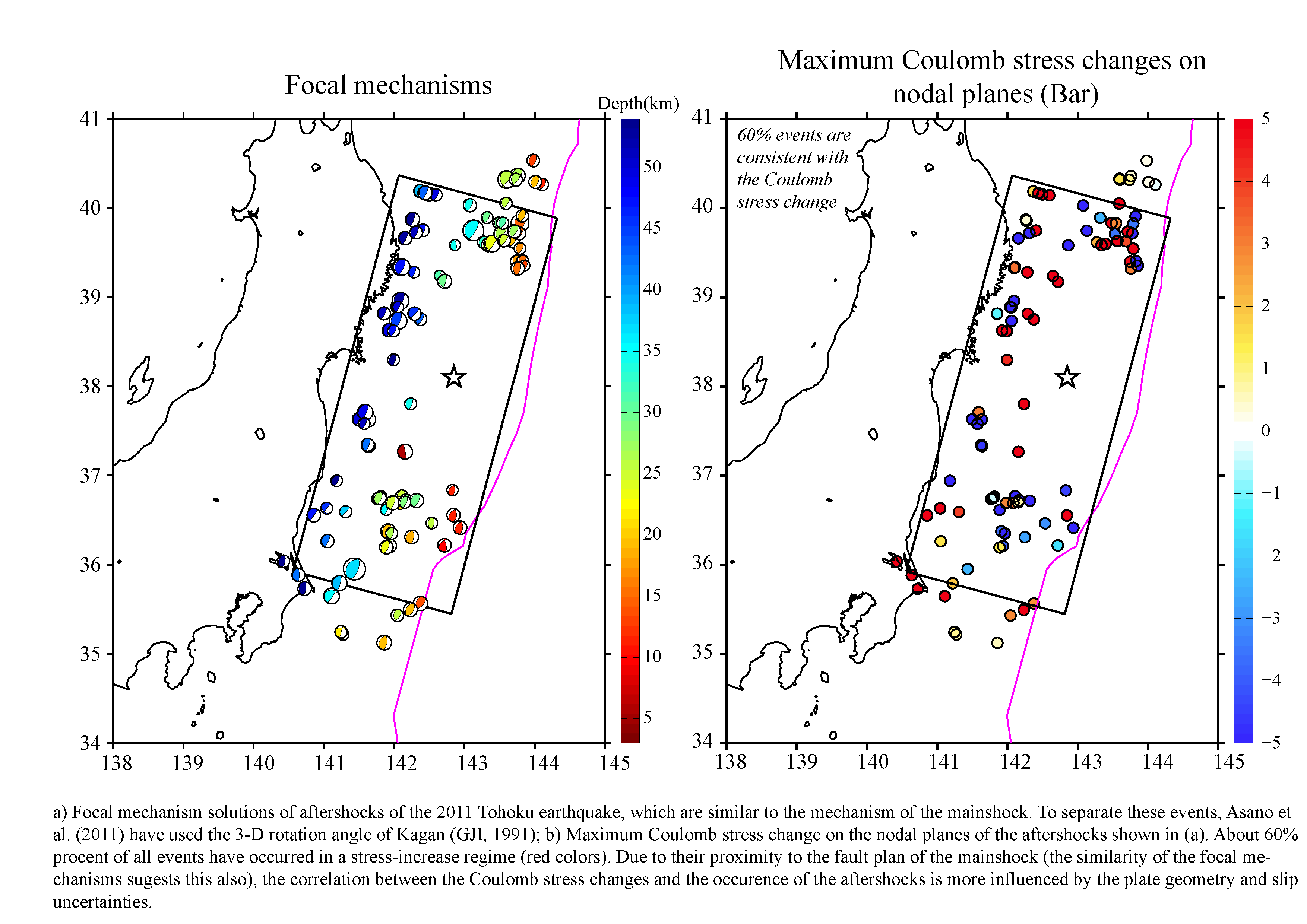
--------------------
Note:
The results reported here are continusly updated. First preliminary
calculations were performed on March 12, 2011. Due to electric power
supply problems in Tukuba city, which was also affected by the major
recent
event, we had to delay posting these results.





